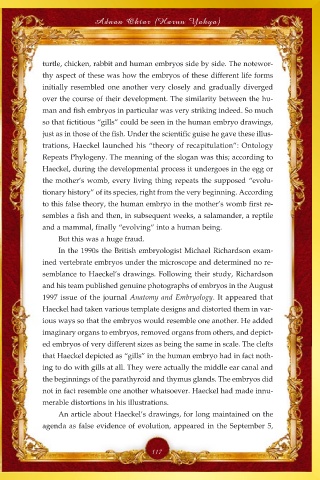Page 119 - Death of the Darwinist Dajjal System
P. 119
Adnan Oktar (Harun Yahya)
turtle, chicken, rabbit and human embryos side by side. The notewor-
thy aspect of these was how the embryos of these different life forms
initially resembled one another very closely and gradually diverged
over the course of their development. The similarity between the hu-
man and fish embryos in particular was very striking indeed. So much
so that fictitious “gills” could be seen in the human embryo drawings,
just as in those of the fish. Under the scientific guise he gave these illus-
trations, Haeckel launched his “theory of recapitulation”: Ontology
Repeats Phylogeny. The meaning of the slogan was this; according to
Haeckel, during the developmental process it undergoes in the egg or
the mother’s womb, every living thing repeats the supposed “evolu-
tionary history” of its species, right from the very beginning. According
to this false theory, the human embryo in the mother’s womb first re-
sembles a fish and then, in subsequent weeks, a salamander, a reptile
and a mammal, finally “evolving” into a human being.
But this was a huge fraud.
In the 1990s the British embryologist Michael Richardson exam-
ined vertebrate embryos under the microscope and determined no re-
semblance to Haeckel’s drawings. Following their study, Richardson
and his team published genuine photographs of embryos in the August
1997 issue of the journal Anatomy and Embryology. It appeared that
Haeckel had taken various template designs and distorted them in var-
ious ways so that the embryos would resemble one another. He added
imaginary organs to embryos, removed organs from others, and depict-
ed embryos of very different sizes as being the same in scale. The clefts
that Haeckel depicted as “gills” in the human embryo had in fact noth-
ing to do with gills at all. They were actually the middle ear canal and
the beginnings of the parathyroid and thymus glands. The embryos did
not in fact resemble one another whatsoever. Haeckel had made innu-
merable distortions in his illustrations.
An article about Haeckel’s drawings, for long maintained on the
agenda as false evidence of evolution, appeared in the September 5,
117

